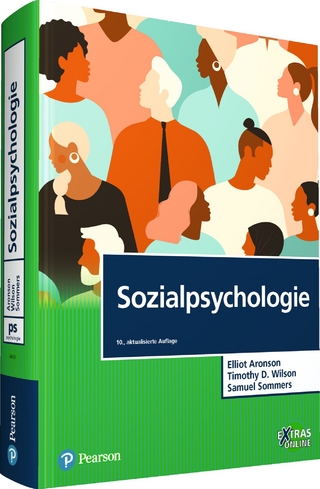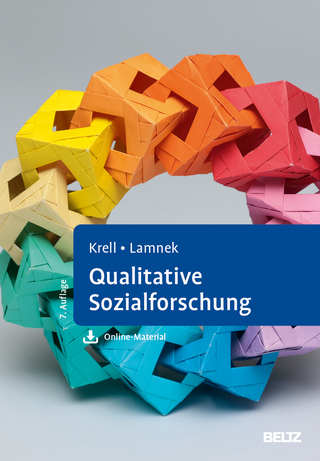
Symbolic Interaction in Society
Rowman & Littlefield (Verlag)
978-1-5381-0107-0 (ISBN)
Core text for the symbolic interactionism course - often called "Self and Society" or "Individual and Society" - taught in sociology departments.
Symbolic Interaction in Society provides a systematic application of symbolic interaction to society. In addition to providing an overview of the theory and methods of symbolic interaction, it includes theory and research related to all of the relevant topics in sociology today: race and ethnicity, gender and sexuality, social institutions, and social change.
Key features include:
A comprehensive review and application of symbolic interaction to every aspect of the study of societyFull review of the theories symbolic interaction to include a discussion of the nature of society and the role of the individual in societyA solid examination of the qualitative methods symbolic interactionists employ to study the self in societyReview of the role of self and presentation of the selfResearch applications of symbolic interaction to examine major sociological outcomes such as inequality (race, class, gender and sexuality, family and other social institutions, and social change)Classic and Contemporary readings built into each chapterStudent applications in which students are encouraged to employ symbolic interaction to the world around them
David E. Rohall is Department Head and Professor of Sociology at Missouri State University.
Chapter 1. The Social Construction of Reality
This chapter examines the history and basic tenants of symbolic interaction and its relationship to the field of sociology. The primary goal of this chapter is to provide a cohesive sense of the nature of society and the individual's relationship to it.
I. This Book Isn't Real!
A. Basic Principles
B. Everything Is NOT Relative
C. Framing and Interaction Rituals
II. The Construction of Society
A. The Individual in Society
B. Two Schools of Symbolic Interaction
Chapter 2. Studying Symbolic Interaction
Symbolic interactionists traditionally apply qualitative methods to study the social construction of meaning. The goal of this chapter is to provide students an appreciation for qualitative research as well as a guide to conduct their own research.
I. Quantitative and Qualitative Methods in the Social Sciences
II. Studying Situations
A. Ethnography
1. Participant Observation
2. Ethnomethodology
3. Alternatives: The Autoethnography and Flash Ethnographies
C. Interviewing
D. Narrative Analysis
E. Natural Experiments
Chapter 3. Constructing Culture
The cybernetic approach to the individual and society is reviewed in this chapter. Culture is socially constructed but culture, once constructed, provides the building blocks of individual situations. The meaning that individuals place on group activities and material artifacts is a manifestation of interactionist principles. This chapter analyzes how individuals construct culture as well as the development of culture in small groups and subcultures within society.
I. Elements of Culture
A. Statuses, Roles, and Norms
Mores vs. Folkways
B. Values and Beliefs
Sapir-Whorf Hypothesis
C. Symbols and Language
II. American Culture
William's American ValuesBaudrillard's AmericaIII. Creating Cultures
Subcultures and IdeoculturesGlobal Culture?Cultural Change
Chapter 4. Self and Society
Most books on symbolic interaction emphasize the relationship of the self and society. In this chapter, we focus on the self, the self-concept, and the presentation of self which represent the impact of society on the individual.
I. The Self as a Process
A. Self vs. Self-Concept
B. Situational Selves
C. Self-Narratives
II. Identity and Social Identity Theories
A. Defining Identity
B. Principles
III. Dramaturgy
A. Front-Stage/Back-Stage
B. Impressions Given/Impressions Given-Off
Chapter 5. Socialization
This chapter reviews how we come to incorporate society into our cognition and how children are raised and learn new things as well as how they are independent participants in this process. This chapter also examines how adults continue socialization processes as they become members of new groups and organizations.
I. Cognitive Socialization
II. The Sociology of Childhood
A. Stages of Development
B. Children's Cultural Routines
C. Agents of Socialization
III. The Looking-Glass Self
IV. Adult Socialization and Desocialization
History and the Life CourseThe Generalized Other
Chapter 6. Emotions and Relationships in Society
Here, students are introduced to the study of emotions and relationships, how people come to like or dislike other people, in addition to relationships as the foundation of community and society through neighboring and other processes.
I. Contextualizing Emotions
II. Dramaturgy and Emotions
A. Emotional Scripts
B. Feeling Rules
C. The Social-Emotional Economy
III. Emotions and Society
A. Emotional Socialization
B. Interaction Ritual Chains
IV. Constructing Relationships
A. Situational Basis of Attraction
B. Relativeness of Commitment
C. Community
Chapter 7. Constructing Inequalities: Race, Class, Gender and Sexuality
This chapter examines how people experience their race, class and gender, how those concepts are formed and manipulated in interactions, and those identities impact interactions with other people.
I. Basic Stratification Processes
A. Stratification Processes
1. Stratification and who we interact with
2. Stratification and the role of status
3. Stratification Ability to define the situation
B. The Process of Othering
II. Stereotyping and Prejudice
III. Doing Difference
A. Doing Gender
B. Intersectionality
IV. Rigging the Game
A. Networks and Social Capital
B. Theory of Group Position
Chapter 8. Institutional Life: Family, Education, Religion, Economy, Politics
This chapter examines the concept of the social institution, how they are socially constructed and how people negotiate meaning within these social structures.
I. The Nature of Social Institutions
II. Institutions
A. Family
B. Education
C. Economy
D. Religion
E. Politics
III. Creating New Institutions
Chapter 9. Deviance
How people define what is deviant or what is normal. How people learn to be deviant or normal.
I. Defining Normal
A. Types of Deviance (Criminal vs. Mental)
B. Agents of Social Control
II. Labeling and Delabeling
A. Principles of Labeling Theory (Primary and Secondary)
B. Deviant Subcultures
C. Leaving the Deviant Identity
III. Stigma
A. Madness and Civilization
B. The Myth of Mental Illness
C. Total Institutions
Chapter 10. Social Change
The book ends with a review of theory and research about social change, how people are able to make social change both interpersonally and in the larger community.
I. Theories of Protest Behaviors
A. Mass Hysteria Theory
B. Theory of Circular Reaction
C. Emergent Norm Theory
II. Collective Memory
III. Other Social Movements
A. Flash Mobs
B. Internet Communities
| Erscheinungsdatum | 08.01.2019 |
|---|---|
| Verlagsort | Lanham, MD |
| Sprache | englisch |
| Maße | 158 x 239 mm |
| Gewicht | 485 g |
| Themenwelt | Geisteswissenschaften ► Psychologie ► Sozialpsychologie |
| Sozialwissenschaften ► Soziologie ► Allgemeines / Lexika | |
| ISBN-10 | 1-5381-0107-6 / 1538101076 |
| ISBN-13 | 978-1-5381-0107-0 / 9781538101070 |
| Zustand | Neuware |
| Haben Sie eine Frage zum Produkt? |
aus dem Bereich


